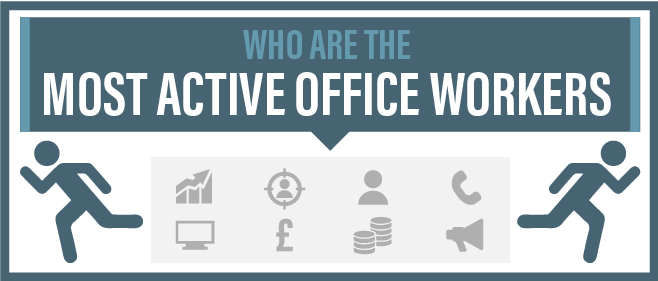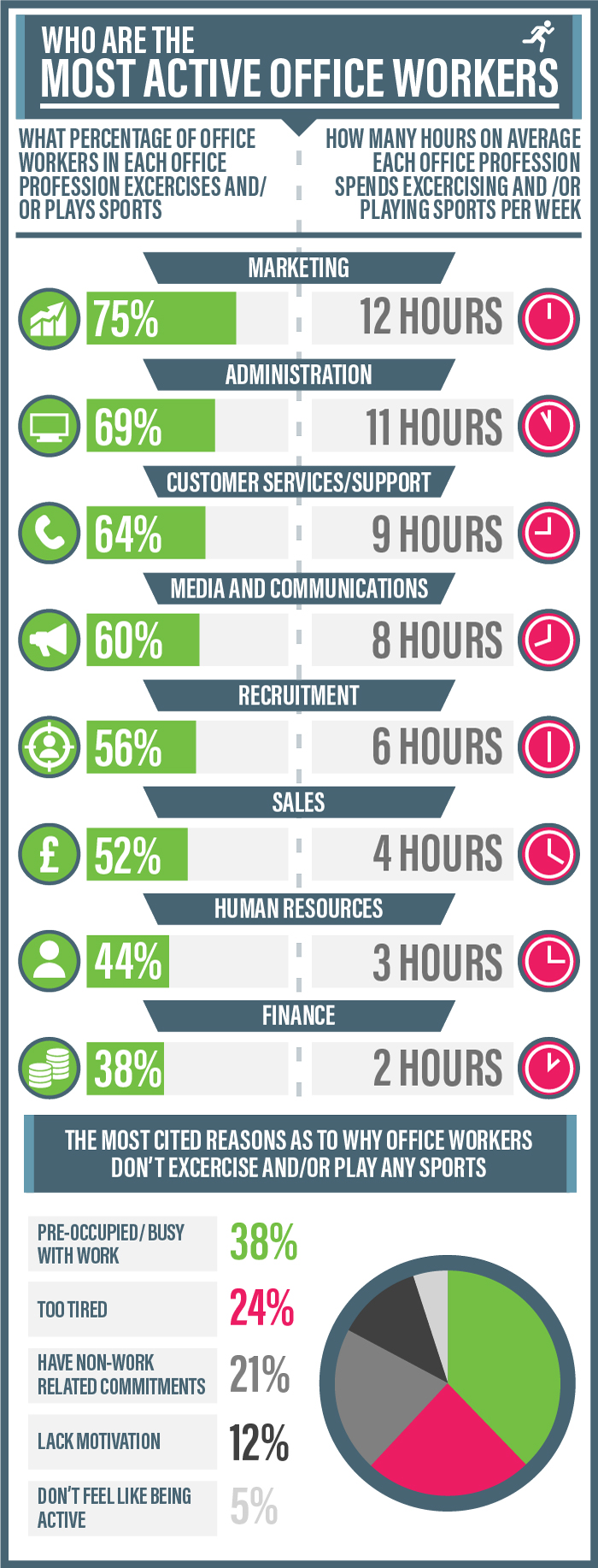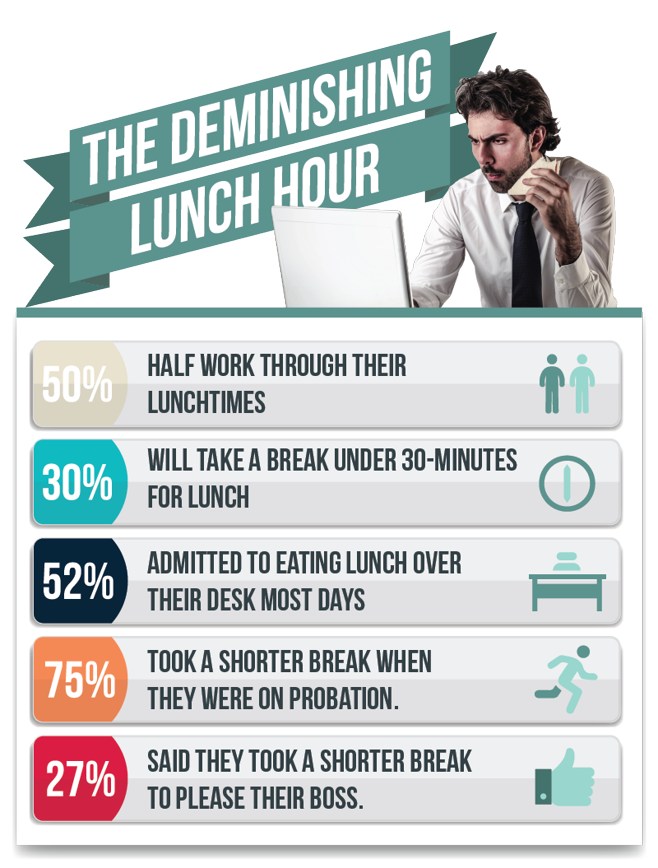BLOG
Who are the most active office workers?
Mar 29 2017
Darren Best

Our Research
At SavoyStewart.co.uk, we wanted to find out who are the most active office workers, conducting a survey to find out just that. The survey had 720 office workers from eight different professions. These eight-profession included those in the fields of: Marketing, Administration, Customer Service/Support, Media & Communications, Recruitment, Sales, Human Resource and Finance. Each respondent was presented with a range of questions including whether they did any exercise and/or play any sports and if so, how many hours per week. Moreover, we sought to find out from those that didn’t exercise or play a sport as to why that was the case.
Share this Image On Your Site
The Findings
Our research surprisingly found that those individuals in marketing were the most active office workers. 75% of marketing professionals exercise and/or play sports for an average of 12 hours per week. Marketing professionals were followed by those in administration roles. 69% of those in administration positions exercise and/or play sports for an average of 11 hours per week. The third most active office workers were those in customer service/support, with 64% exercising and/or playing sports for an average of 9 hours per week. The least active office workers were those in finance positions. 38% of those in finance exercise and/or play sports for an average of 2 hours per week. Comparatively, those in human resources were slightly more active as 44% stated they exercise and/or play sports for an average of 3 hours per week. Photo credit: rawpixel.com/Shutterstock
Photo credit: rawpixel.com/Shutterstock
Employee Perspectives
“In my current role, I am very busy. Every day is hectic, as I have a ton of duties and responsibilities to attend to. Just because of the scale of the workload, I usually start very early and finish late, just to ensure I get everything done on schedule. As much as I want to go the gym during the week, there just isn’t enough time. On weekends, I am usually very tired and try to catch up on sleep, therefore lack the energy to do anything physically demanding”. – Chris, Financial Analyst from Bristol “I work for a very large organisation where the natural expectation is to consistently go beyond what’s expected. Every report, project and task therefore needs to be outstanding. To meet this expectation, I usually find myself working very long hours during the week and occasionally, some weekends. The ever-impending pressure to constantly add value means there is a lack of time for me to do things that I enjoy. This includes badminton and tennis which I am very passionate about”. – Judy, Senior Human Resource Coordinator from London “Whilst I am generally busy, my work load is generally manageable. I don’t feel overwhelmed or stressed in my job; rather always optimistic. I get everything done within the appropriate time frame and the company never puts an emphasis on staying beyond the normal working hours. This is great for me and my colleagues because it usually allows us to go the gym or for a run together after work. These sessions do not only improve our personal fitness but provide a great opportunity for us to bond and improve the team dynamic”. – Jacob, Marketing Assistant from Liverpool Photo credit: g-stockstudio/Shutterstock
Photo credit: g-stockstudio/Shutterstock
Expert Opinions
“Businesses now more than ever are working at a rapid pace in the backdrop of an uncertain economic climate, thus expect their employees to continually give their all. Whilst it’s understandable from their point of view, they must not over burden employees with drastic workloads and expectations. When companies do this, they are not only overstretching their work force but taking away valuable time they have outside of work. This includes time they could be spending to improve or enhance their fitness levels after being sedentary throughout the working day”. – Barry Desmond, Business Development Coach from London “Being a fitness enthusiastic myself, I always encourage my employees to be active as possible. Whenever I go to the gym or boxing before work, I always feel more focused and on the ball. Consequently, I am a huge advocate of encouraging my employees to eat away from their desks and go for walks during their lunch break. Additionally, I never insist nor encourage any of them to stay beyond our normal working hours. I would much rather they go home, to the gym or enjoy their preferred sports after work”. – Martin, Senior Managing Director of a Digital Marketing Agency in Leeds “This research is certainly fascinating. With the associated risks of being inactive for long periods of time well documented, it’s imperative that office workers make every effort to be as active as possible. With various avenues to improve fitness whilst at work, as well as outside of work, employees should aim to integrate some form of physical activity into their daily routine. Employers also have a role to play, as they can harvest a culture whereby employee wellbeing is at the forefront of their ethos. This includes subtle things such as not overloading employees with work so they have the time to pursue activities that will allow them to stay energised and focused”. – Darren Best, Managing Director of Savoy StewartSix Effective Ways to Be Active During the Working Day
As well as having some form of physical activity outside of work, office workers can also make some small changes to their daily behaviour to gain much needed movement. Photo credit: rawpixel.com/Shutterstock
Photo credit: rawpixel.com/Shutterstock
Integrate Walking into Your Commute
The majority of office workers don’t have the luxury of living close to their office, therefore walking to work is not always a viable option. If you are using the rail, tube or overground – then aim to walk to the station if it is within a manageable distance and try to get off one stop earlier, to gain a short walk. Likewise, in the case of driving, park a short proximity away from your workplace, so you can fit in a small walk in the morning as well as when leaving work.Avoid lifts and escalators
It can be a difficult habit to break out of if you have become accustomed to using lifts and escalators at work but opt to use the stairs instead. You may feel it is pointless but every step counts as your body is benefiting from the valuable movement. Photo credit: gpointstudio/Shutterstock
Photo credit: gpointstudio/Shutterstock
Get your own coffee
Instead of getting someone else to get your coffee, tea or smoothie for you – take the initiative to get up and get it yourself. It will provide you with a short burst of fresh air.Get up every hour
Instead of sitting at your desk for a long period of time, attempt to get away from your desk every hour. This doesn’t mean going outside to take a long walk, simply stroll over to see a colleague or get a glass of water to hydrate yourself. Likewise, if you feel up to it – do some stretching exercises.Use your lunch hour
Instead of eating or working through lunch at your desk, use the opportunity to be active. Going for a short or long walk will not only clear your mind from any work-related stress but give you time to re-energise for the afternoon. Additionally, organise a group of colleagues to go on walks with – their company is a wonderful way of socialising.